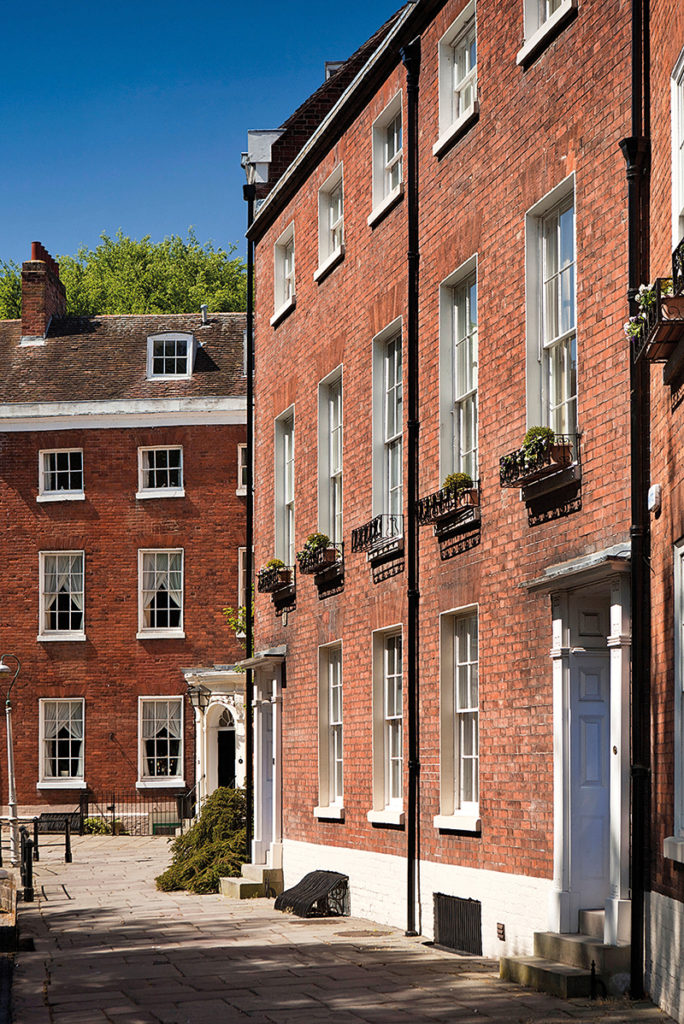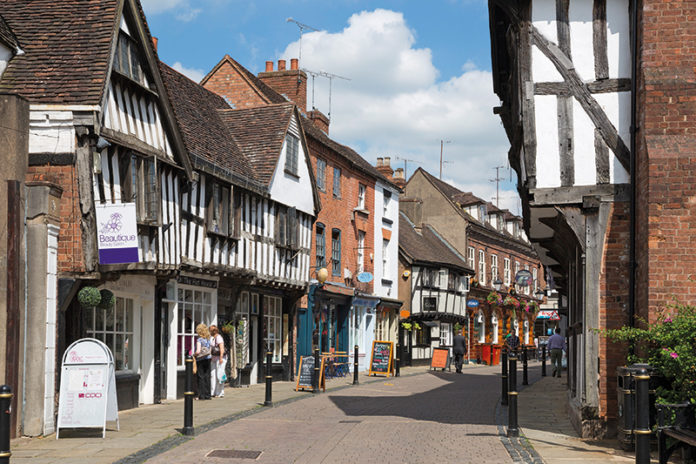This Midlands city offers medieval architecture surrounding one of England’s prettiest cathedrals
Set close to the dramatic Malvern Hills and astride the River Severn, Worcester has been attracting visitors for centuries. With a history that predates the Romans, its blend of Tudor and Georgian architecture make its oldest streets an enchanting place to wander, stop for afternoon tea or browse the independent stores.
Worcester is known as the ‘Faithful City’, although this has little to do with its impressive centrepiece, the stately cathedral, but rather its role in the English Civil War during which it remained staunchly faithful to the Crown.
Worcester Cathedral

Yet, for many, the biggest draw of the city is Worcester Cathedral, believed by some to be the most beautiful cathedral in England. Founded in the 7th century, Worcester Cathedral has many stories to tell. The structure that stands today dates from the 11th century and features a variety of architectural styles, from Norman to Perpendicular Gothic.
The cathedral was a priory – one of the most important in the country – until Henry VIII dissolved it during the Reformation and it became a cathedral. One of its most significant tombs is that of Henry’s older brother, Prince Arthur, who was heir to the throne in the 16th century and whose death changed the course of British history.
Following his brother’s death, Henry VIII became king and married Arthur’s widow, Catherine of Aragon. Later, it was Henry’s determination to divorce Catherine that led England to break from Rome.

The cathedral is also the resting place of King John, who died in 1216, and requested to be buried in Worcester. His tomb features a lifelike image of the king and is the oldest royal effigy in England.
On weekends and school holidays you can climb the cathedral’s magnificent tower and admire the clock chamber and bell chamber. It’s also worth taking some time to visit the medieval cloisters and ancient crypt, and to take in the impressive Victorian stained glass.
Cultural heritage

The city and its surroundings also boast impressive connections to English culture: the city’s most famous son, Sir Edward Elgar, composed some of Britain’s most recognisable classical works, including Variations on an Original Theme, Op. 36, also known as the Enigma Variations, which were inspired by his childhood in Worcestershire.
Similarly, JRR Tolkien, author of The Hobbit and The Lord of the Rings, based the setting of ‘The Shire’ on his early years spent in the Birmingham suburbs.
Worcester is also famous for its porcelain, and although the factories are closed, its heritage lives on in the Museum of Royal Worcester.
Finally, for a glimpse of striking architecture, head to the city’s newest attraction – its daringly modern library, The Hive.
The essentials
Getting there Direct trains run from London’s Paddington through picturesque Oxford and the Cotswolds on a service dubbed ‘the Cathedrals Express’. There are also regular services from Birmingham New Street that stop at Worcester Foregate Street in the city centre.
Where to stay Combine your accommodation with a visit to the city’s oldest inn. The Cardinal’s Hat dates from the 14th century. This snug, wood-panelled inn has six bedrooms named after notable Worcester folk. Rooms from £82.50, including breakfast, which is delivered to the room in a hamper.
Where to eat The Old Rectifying House is set in a former distillery, from which it takes its name: rectification refers to the purification of spirits to produce a high concentration of alcohol. It’s now a charming pub serving hearty English dishes. For Italian food, try the locals’ favourite, Galleria Italiana.
What to do To learn more about Worcester’s loyalty to the Crown during the English Civil War, visit The Commandery, which was the Royalist headquarters during the Battle of Worcester in 1651 – the decisive battle of the war. Admire the impressive Great Hall and a variety of weaponry while you learn about this significant period of English history from the fascinating displays.

It’s not often you find a National Trust property in a city centre, but Greyfriars’ House and Garden is a late medieval merchant’s house from 1480. Worcestershire is famous for its black-and-white timber-framed houses. These buildings have been used as homes and shops over the years and were rescued from demolition in the 1930s. Inside this example, you’ll find an array of ornaments, wall-hangings and antique furniture.
One of Worcester’s most striking attractions is its newest: The Hive is the first joint public and university library in Europe and is set in a distinctive building inspired by the kilns of the Royal Worcester porcelain factory and covered in golden tiles. Inside, its architecture is equally impressive with a grand ash wood staircase. There’s a café at its heart, while the archives hold William Shakespeare and Anne Hathaway’s marriage bond.
Of course, you can’t visit Worcester without a nod to its famous Royal Worcester porcelain. Located near the former factories, the Museum of Royal Worcester holds some 10,000 ceramic objects – the largest collection of Worcester porcelain in the world. Although the galleries are under refurbishment until May 2018, the new-look museum promises to be an
even greater draw.
Shop The most attractive shopping streets are Friar Street and New Street, with their medieval architecture, but the biggest hub is the Crowngate Shopping Centre offering a range of high-street stores. Independent boutiques can be found in Reindeer Court and The Hopmarket.

Explore Take a trip along the River Severn with Worcester Boat Trips, who give a captivating commentary on the sights, sounds and history linked to the route. If you want to get out of town, then head to the Malvern Hills, classed as an Area of Outstanding Natural Beauty. The dramatic hills are ideal for walking and the views of the Severn Valley are unparalleled.
Read Jerrold Northrop Moore’s poetic book Elgar: Child of Dreams (Faber & Faber, £8.99) sets out the story of an extraordinarily creative life and links the composer to the Worcestershire landscape that formed the backdrop to his work.
Live like a local
Helen Large, Marketing & Events Manager, Museums Worcestershire

I love Worcester because it has such a rich and diverse heritage, a fabulous range of independent shops and a beautiful riverside. As it is so compact, you can explore everywhere on foot, from Worcester City Art Gallery and Museum in the north to the historic Commandery in the south, visiting the bustling high street in between. Friar Street and New Street offer some great places to eat and shop – my favourites are Mac and Jac’s Café-Deli on Friar Street, and Iapetus craft shop in Reindeer Court.
In February, the Love Worcester Heritage Festival sees all the historic venues in the city, from The Infirmary medical museum to the beautiful cathedral, stage events, bringing the city’s past to life.
This year, the art gallery and museum will be celebrating Worcester’s most famous artist, Benjamin Williams Leader, in an exhibition (17 February to 2 June) bringing together many of Leader’s most significant works for the first time.
Words: Carolyn Boyd






 © 2024
© 2024